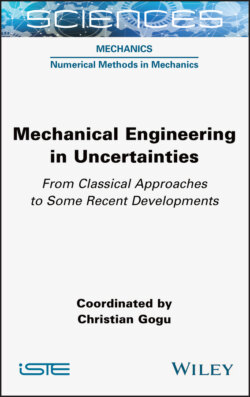Читать книгу Mechanical Engineering in Uncertainties From Classical Approaches to Some Recent Developments - Группа авторов - Страница 9
Оглавление
Foreword
Maurice LEMAIRE
SIGMA Clermont, Clermont-Ferrand, and Phimeca Engineering, Cournon, France
For centuries, mechanics has been a rational science motivated by astronomers observing the solar system with remarkable predictions of ephemeris, until Henri Poincaré brought out the chaos. For their part, the builders knew that their forecasts could be thwarted by dubious or unforeseen events, of which they were protected from by the so-called safety coefficients introduced by Claude-Henri Navier.
The 20th Century was marked by advances in materials and mechanical system behavior models, and by the considerable development of digital solutions. However, there will always be an uncertain gap (not an error) between the model and the physical reality.
If Andrey Kolmogorov made the theory of probabilities quasi-perfect, the statistical model necessary for its implementation remains, and will remain, uncertain in mechanics, even if the big data of the 21st Century will bring much to the exploration of the Mediocristan (the life around the median), but little to that of the Extremistan (the life at borders), according to the mapping of Nassim-Nicholas Taleb.
Immersed in the uncertainties of its models and its data, the domain of mechanics was initially based on expertise and feedback to justify its new works. Only recently did it realize that probability theory could provide an additional precision, by eliciting the content of its rules and codes. Engineers gradually accept to go from quantities of interest justification by a deterministic calculation, to their probability distributions acceptance stressing the failure.
This paradigm shift is cultural, scientific and technological all at once. It is cultural because it involves a new way of thinking that both scientific and educational communities were unprepared for. Mechanics of materials and structures, statistics (often limited to process control) and probabilities fall under disciplinary fields independent from one another.
It is scientific because it involves new algorithm development, recognizing the uncertain nature of models and parameters by the probability theory or other approaches. It is technological because it involves a new approach to rules, now based on probabilistic content, like the EN Eurocodes did. Finally, it involves thought on the decision: to entrust it to the probabilities in Mediocristan and to the consequences of the failures in Extremistan.
Some visionaries became aware of the importance of variability from the beginning of the 20th Century. A reliability index concept introduced in 1949, by Rzhanitzyn in steel construction, was quickly popularized because of the need to provide answers to new situations, for example in off-shore platforms engineering, and by the development of computer tools, which is now motivating methodological works to be implemented numerically.
Since the early 1980s, several scientific communities in the world have gradually seized the subject, bringing more arguments to the probabilistic approach and giving it a scientific consistency and operational tools exiting academic applications. Allow me to have the pleasure of pointing out that the Clermont-Ferrand team has done its part.
Christian Gogu joined talented authors from university centers and research organizations to contribute to the Mechanics and Uncertainty French School, and I want to congratulate them.
In this book, the reader will find a clarification of the concepts of epistemic and random, because the first requirement is to ensure that the vocabulary is not random. This book’s contents provide details about historical methods, as well as the introduction of methods that overcome their shortcomings. It addresses the issue of sensitivity factors, essential for both reliability and optimization. It sheds light on the fundamental uncertainty of the statistical model, which should be considered as fractal. It takes into account the uncertainty of the models and not only that of the parameters. It gives meaning to the notion of optimization with uncertain variables.
However, it leaves open questions on the curse of dimensionality and on the time-variant problem; it will be the topic of the next edition in the coming years. It illustrates the approaches by various technological fields in mechanical engineering for aeronautical and space engineering, and in civil engineering for nuclear engineering. In this book the reader will find both matter to initiation, as well as an introduction to advanced tools.
I hope that this book will be a motivation for researchers, and especially young researchers, to find a scientific field in which to express their skills, where it is necessary to innovate for the scientific and technological progress of humanity.
November 2020
